How the Fine Gael Whiz-kids sold us a Taoiseach
Introduction
The day of the count in the donegal by-election in November 1980 was the low point in Garret FitzGerald's leadership of Fine Gael. The party had dropped votes to a Government which Fine Gael fondly believed would prove easy opponents in the looming general election. The promise which tantalized Fine Gael of a major reversal in electoral fortunes seemed about to dissipate. Within days of that set-back there came together, at first informally, a group of backroom Fine Gael strategists who were to mastermind the most remarkable transformation of a political party in such a short period of time in the history of the state.
In just two years Fine Gael was to become the most professional political organisation in the country. There could be many legitimate queries about the nature of this professionalism, notably the strong reliance on the marketing dimension of politics and the concomitant neglect, almost, of the policy or substantive area.
But in terms of political or rather electoral effectiveness, this team was the best Irish politics has seen in recent times. The devastation at the polls in 1977 convinced many in Fine Gael that it would be at least a decade before the party had a chance of returning to power, even in partnership again with Labour. Fianna Fail had swept the boards with its second ever highest percentage vote and a thumping 20 seat majority over all the opposition parties. Fine Gael had slumped to just 30.5% of the first preference vote, its lowest figure since the 1957 election, and a pitiful 43 Dail seats, as compared with 84 for Fianna Fail.
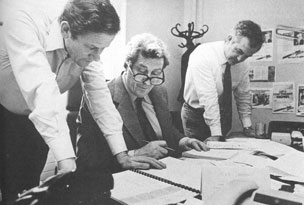
It is against that background that the dimension of the recent Fine Gael achievement can be best appreciated. In just five years the first preference vote has jumped from 30.5% to 39.1 %, the highest ever achieved by the party and higher indeed than its predecessor, Cumann na nGaedheal, ever achieved. Its performance in terms of seats is even more impressive, for with 70 seats, far more than it ever had, and being only five seats behind Fianna Fail, there is a real possibility that shortly the latter's pre-eminence in Irish politics may be eclipsed.
While it would be mistaken to ignore the critical impact that the Fine Gael general secretary from 1977 to 1981, Peter Prendergast, had in revitalising the organisation and, of course, the rejuvenating impact Garret FitzGerald had on the party, the role of the strategy committee was vital. It harnessed the enthusiasm that FitzGerald's leadership had inspired and co-ordinated the organisational resurgence which Prendergast had generated.
Derry Hussey - Chairman
From the beginning the key people on the strategy committee were Derry Hussey, Sean Murray, Shane Molloy, Enda Marren, Sean O'Leary and Peter Prendergast. Others joined the committee later on and politicians drifted on and off from time to time but these were the key people from the outset.
Derry Hussey, the financial director of the Jones Group, now aged 48, first became involved in Fine Gael in 1973 and later became chairman of the Dublin South East constituency executive - Garret FitzGerald's constituency. He remained on in the party after his wife, Gemma, first became involved in the Women's Political Association and then stood successfully for the Senate on the NUl panel. Both the Husseys were social friends of Garret and Joan FitzGerald - they became very much part of the now notorious D4 set. But Derry Hussey didn't conform much to the stereo-type image of that social strata. He was very tough, very clear minded and very coherent. It was obvious from the beginning that he had real co-ordinating qualities and he was appointed chairman of the strategy committee and was to playa crucial role.
Sean Murray - Finance
Sean Murray (38), was another vital cog. He had been brought into Fine Gael by Sylvester Muldowney, with whom he did his articles as a trainee accountant. Muldowney had been a trustee‡ of Fine Gael for several years and a closeassociate of Liam Cosgrave. He brought Murray onto the Capital Branch of Fine Gael (the equivalent of Fianna Fail's Taca) andthis was to be Murray's only formal association with the party until 1981. In fact the Capital Branch more or less went out of existence following the 1977 election and it was at Garret FitzGerald's personal invitation that Murray was brought onto the strategy committee.
Murray's role was first to monitor expenditure. Fine Gael having acquired new premises was finding it hard to meet its costs and there was a real fear that in a general election campaign the party would go bankrupt. Murray laid down strict budgets and cost controls and then started, largely on his own initiative, to raise the finance. A finance committee was constituted under the chairmanship of Vincent Ferguson, and comprising 10 to 12 people, most of whom demanded that their anonymity be protected. They compiled lists of potential backers from professional registers, lists of companies etc. At first it was very random and didn't produce much results but bit by bit tight lists were assembled and the money started to roll in.
But Murray was even more successful in managing to persuade the constituency organisations throughout the country to come through with the finance. This accounted for only one-fifth of the money raised overall during the three election campaigns but was a significant improvement on previous revenue totals from that quarter. In all over £1.6m was gathered by Fine Gael for the three campaigns. Most of this came by way of sums in the region of £50 to £300. There were three donations of over £10,000 and some hundred above the £1,000 mark. As is usual with Irish political parties, the source of the funds remains a secret.
About £600,000 plus was spent on the 1981 election, about £500,000 on the February election and £400,000 plus in November. In all elections Fine Gael came out with a net profit - the party's current finances weren't affected at all by the elections, in contrast to what happened in both Fianna Fail and Labour. Murray operated very much separate from the committee in the financing function but he had a key role to play in expenditure control.
Shane Molloy - Advertising
Shane Molloy (38), marketing director with Lever Brothers, came late to Fine Gael. His first involvement was in the Dublin Euro-election campaign in 1979, which was managed by Enda Marren. Following that campaign he came onto a communications committee headed by Ted Nealon, then the party's press officer, and immediately assumed responsibility for advertising.
A broad framework was drawn up prior to the 1981 election but this was virtually scrapped on the publication of the Fine Gael policy document for the '81 campaign, which contained the proposals on tax credits, the £9.60 for stay-at-home spouses etc. That meant that a great deal of the advertising effort for the '81 campaign was put into explaining the basics of the proposal. Over £200,000 was spent on press and poster advertising (mainly press). The campaign ended up, as planned, with a strong emphasis on Garret FitzGerald's leadership qualities but in retrospect there were grave doubts about the effectiveness of the overall strategy at that time. It was not that the advertising campaign had not been competent but rather that the strain in getting across such radically new concepts during the course of a campaign was excessive. Also the campaign ran out of steam near the end.
There was also the problem of "response" advertising- ie. reacting to the course of the campaign and especially the accusations of the opposition. This tactic led Fine Gael into the "nail the lies" series of advertisements, which included as lies, the suggestion that Fine Gael would impose VAT on clothes and footwear. Later on, Molloy was to conclude that a campaign should not be deflected from its original strategy, however unsure that policy should appear in the heat of an election.
Molloy was also to re-assess later on the full page advertisement strategy in newspapers. He came to believe that it was too heavy and a three-quarter page advertisement such as deployed in the recent campaign - could do the job at least as effectively. Incidentally, Fianna Fail used double page spreads in the Sunday newspapers on the weekend before the June '81 poll. This was considered by Fine Gael to have been entirely counter-productive for it resulted in many readers simply skipping across those two pages.
There were three campaigns used in the 1981 election. One general, to the electorate at large, another directed at young people, and another at women. The advertising agency used was Arks and the procedure usually adopted was that Molloy would brief the agency in detail and the copy writers and visualisers in the agency would be responsible for the preparation and presentation of the advertisements themselves.
The February 1982 advertising strategy was very different. In the first place it was defensive by its very nature and there were no positive policies to put across. Greater reliance was made on Garret's image as a credible communicator of the serious plight of the economy and of the need to take drastic corrective action. Some of the mistakes of the 1981 campaign were repeated in February and the old advertising adage "you waste half your advertising budget but the problem is you don't,know which half" was very relevant then.
The November 1982 campaign went more smoothly. The lessons of previous campaigns had been learned but, more critically, sophisticated qualitative market research had been done to identify the mood of the electorate and the issues which were concerned. And not just the issues which concerned them but the issues which they believed a Government could do something about. For instance, one of the most striking issues thrown up by quantitative research was unemployment but the qualitative research showed that very few people believed that any Government could do much about it. So too with inflation. But it did become clear that people did think that a Government could protect existing jobs, if not create any new jobs.
Therefore, the strategy behind the November 1982 campaign was very much based on the theory that the people were not so much concerned with stability but with uncertainty. People were concerned about their future and their children's future. The advertising approach was to suggest to people that they could do something about relieving this uncertainty by taking action at the polls - "change for the better", as the Fine Gael slogan stated.
The concept of the unity of the Fine Gael team was used throughout all three campaigns. This was not so much asa matter of contrast with Fianna Fail's lack of unity but rather as an attempt to exploit Garret FitzGerald's high rating in the polls, a rating which far exceeded that of his party. Hence the continued use of the phrase "Garret's team".
In a further effort to lift the Fine Gael rating, emphasis was placed in the November campaign on the other personalities in Fine Gael who had been perceived by the electorate, according to the opinion polls, as having performed well in Government - John Bruton, Peter Barry, Alan Dukes and Jim Mitchell. The idea was to suggest that Fine Gael was more than just a one-man band but also a team of many talents.
Enda Marren - Dublin
Enda Marren (47), a Dublin based solicitor, originally from Mayo, was another vital cog in the machine.
He had been involved in the party since 1965 when he helped Pat Lindsay win a seat in Mayo. He became chairman of the Dublin North Central constituency executive in 1967 but became involved on a national level only in 1979 when he was director of elections for Fine Gael in the Euro-elections.
He was an important link in the party between the more traditional element, represented at one time by Pat Lindsay, and Garret FitzGerald's more liberal wing. He achieved a notable success in the Euro-elections in pushing up the Fine Gael vote well beyond the 18% it got in opinion polls prior to the campaign and it was inevitable that he would come onto the strategy committee when it was formed.
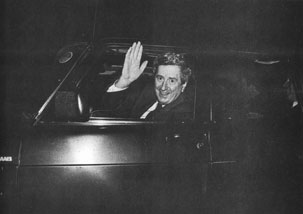 Sean O'Leary - Director of Elections
Sean O'Leary - Director of Elections
Sean O'Leary (41), was brought onto the strategy committee not just as a member but as the director of e1ections designate. It was Peter Prendergast who perceived that having a non-candidate as director of elections was important and Prendergast also acknowledged that he himself could not do the job, having alienated TDs up and down the country by deeming to force on them candidates who would threaten their own seats. O'Leary's appointment was inspired. He had been an unsuccessful candidate himself in Cork city on a number of previous occasions. He had qualified as an accountant in the sixties and then had studied for the Bar in the late seventies and had taken up practice on the Cork circuit in 1980.
He was very determined, knew the constituencies intimately, had a good rapport with directors of elections throughout the country and had a natural authority, which was vital during the course of the campaigns, when decisive leadership, internally in the party, was required. He was also a naturally likeable person and didn't generate the anti‡pathies which Prendergast did among the TDs and others in the party.
Peter Prendergast General Secretary
Prendergast (43), himself was vital to the whole operation. He was FitzGerald's personal choice as general secretary in 1977 and he was almost as crucial as FitzGerald in re-building the entire Fine Gael organisation, literally from top to bottom. It was a ramshackle outfit in '77; when Prendergast left the general secretaryship in '81 it was a well-oiled machine.
He was born in Galway. His father was a bank manager and the family moved first to Castlereagh, Co. Roscommon, and then to Dunmore, Co. Galway. He was educated at Clongowes and UCD and then spent two years in Germany. He returned to join Erin Foods and was responsible for the direct selling of its products in the north of England. He later joined Unilever and became a brand manager, eventually marketing seven brands. He then went into marketing consultancy and was responsible for one of the greatest marketing coups in this country - Yoplait yoghurt.
He joined Fine Gael in 1969 in Dublin South County and assisted in the Tom O'Higgins campaign in that constituency. A few years later he was elected to the national executive. Prendergast appoin ted organisers in each constituency throughout the country. He personally visited most constituencies and set about shaking out the old remnants of inaction, thereby disturbing many vested interests, notably those of the sitting TDs. He was though ruthless and relentless and it was he who prepared the ground for the strategy committee in the run up to the 1981 election.
There were others of course who played considerable roles. Chief among these perhaps was Ted Nealon, who would figure very much more prominently in this narrative were it'not for the fact that he departed from the national scene around April of 1981 to campaign for a seat personally in Sligo-Leitrim. But he had assembled together a group which was later to playa pivotal role and he had established the ground work for the literature, postering etc. which forms such a vital part of election campaigns.
Jim Dooge also played a major part but when he was Minister for Foreign Affairs he effectively dropped out, but both before and after that time he was a very important member of the strategy committee. Alexis FitzGerald (Sm.) was also on the committee early on but he dropped out soon afterwards. There were politician members at the beginning also. Garret FitzGerald himself attended most of the meetings from January to May 1981. So too did Peter Barry and Tom FitzPatrick.
The '81 Campaign
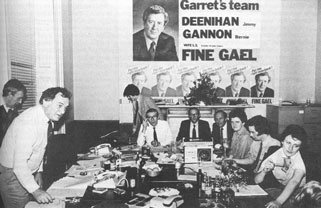
There were a number of informal meetings after the Donegal by-election and then shortly after Christmas 1980, or early in January 1981, the strategy committee held its first meeting in the new Fine Gael headquarters in Mount Street. There were several meetings between then and the general election the following June. Its first task was to set in motion the conventions in the constituencies throughout the country. This exercise contributed greatly to forcing Charlie Haughey's hand in calling an election, for with newly nominated Fine Gael candidates in the constituencies starting their campaigns, the Fianna Fail organisation at grass roots level became restive and pressurised for an early poll. The strategy committee had no part in the policy formulation prior to the 1981 election. Indeed neither did almost any other organ of the party as FitzGerald, in conjunction with economist Brendan Dowling, kept the tax credits idea secret almost to the last moment. Scan O'Leary did get sight of it however and suggested some changes.
The 1981 campaign went almost to plan, although there were some candidate problems in some constituencies. The committee met at 8.00 am each morning in the Berkeley Court Hotel, where Sean O'Leary was staying. Following the 1981 election the strategy committee did a wrap-up report on the campaign and duly went out of business. The wrap-up report identified some of the deficiencies in the campaign strategy, notably the cumbersome nature of the sub-committee dealing with publicity, advertising and literature. It recommended that this be broken up for future campaigns. It also identified some problems ‡both at headquarters and at constituency level but the details of the report remain confidential.
The February Campaign
In the night the Government fell on the budget on January 27, some members of the committee were around Leinster House in anticipation of a possible defeat.
Sean O'Leary had come up from Cork and had been concerned all day that Sean Dublin Bay Loftus's vote had not been nailed down - Loftus at first proclaimed himself satisfied with the budget but then on being quizzed on RTE changed his mind and then felt obliged to vote against.
There was a great deal of confusion in Leinster House after the fall of the Government. The official in the Departmcnt of thc Environment who dealt with elections first couldn't be identified and then couldn't be found, for instance. There was a cabinet meeting when Garret returned from the Park, having obtained President Hillery's assent to the dissolution of the Dail. Then Garret FitzGerald's personal assistant, Katherine Meenan, largely on her own initiative, started to ring around to have the strategy committee convened that night.
Katherine Meenan had become FitzGerald's personal assistant on May 1, 1980. Previously she had been an assistant to the Christian Democratic group in the European Parliament and before then she had worked in Meadow Meats and in the CBF. She is daughter of the UCD Dean of the Faculty of Medicine, Paddy Meenan, and of a staunch Fine Gael family. She was brought into FitzGerald's office to manage the office and to manage FitzGerald himself, in so far as that was possible. She had come on to the strategy committee shortly after it was formed but didn't attend the meetings during the 1981 campaign as she was on tour with Garret. She was one of the key links between the strategy committee and the Fine Gael frontbench, while in opposition - she was secretary to the frontbench.
Almost all the committee members convened in Leinster House that night and the meeting began after midnight. O'Leary was again confirmed as director of elections and the strategy committee was again formally appointed. That meeting was attended by FitzGerald, Peter Barry, Tom FitzPatrick, Jim Dooge, as well as by the people on the committee mentioned earlier, with the exception of Shane Molloy who was ill but who joined the team the following day. Again the committee held their meetings at 8.00 am in the Berkeley Court Hotel, where again O'Leary was staying, during the course of the February election. But it was a very different campaign.
In the first place Peter Prendergast was missing. He had become an assistant to John Bruton in the Department of Finance and was specifically prohibited by Bruton from playing any part in the campaign. The result was that the party was missing a vital cog in its engine room. Prendergast was the person who had dealt with the directors of elections. He was the person with the most intimate knowledge of the constituencies and the organisation as a whole. True, Finbar FitzPatrick of Mallow had taken over from him as general secretary, or rather the announcement to that effect had been made at a hilarious press conference some ten days previously. But in fact FitzPatrick had not in fact taken over and happened to be in Dublin only because of fortuitous leave from his former employer.
He of course joined the team immediately but he was not in a position to give the kind of input which Prendergast had given. This effectively meant, especially given the time constraint, that local problems in constituencies went ignored and serious candidate problems emerged. This was especially true in Sligo-Leitrim and Louth and in both instances Garret FitzGerald himself was to blame for not asserting his personal authority to have the matter sorted out - this was especially true of Louth where the sitting TD, Bernard Markey, threatened to stand down if a Drogheda candidate was imposed. In the event these two failures effectively cost Fine Gael and Labour the election, or rather power.
Then there were major difficulties in liaison with Government Departments. Effectively, the strategy committee's authority was compromised by the rival power centres of the Departments of State. Ministers issued their own statements and made their own running, sometimes without reference to the overall strategy. And then of course there were major problems arising out of the budget. The context in which the election came about could hardly have been worse for Fine Gael. Not alone was there the VAT on clothes and footwear, in contravention of 1981 campaign advertising promises and the Gaiety document, but food subsidies were being abolished in certain instances and there was a lot of disquiet over the raising of the school entry age.
Perhaps the greatest achievement of the strategy committee was to manage to increase the Fine Gael percentage vote from 36.5 to 37.3 in these very adverse circumstances. The fact that this increase wasn't reflected in a seat gain was attributable to the organisational problems which the suddenness of the election posed.
Frank Flannery and the Constituency Review Committee
Effectively, the committee stayed in existence after the February election, although the running was made for a number of months by a constituency review committee which the party's national executive set up. That committee was chaired by Sean O'Leary, who, in the event, was unable to devote much time to it. It comprised of Frank Flannery, Peter Kelleher of Cork, Enda Marren, and four TDs: George Birmingham, Jim Mitchell, Paul Connaughton and Michael Noonan.
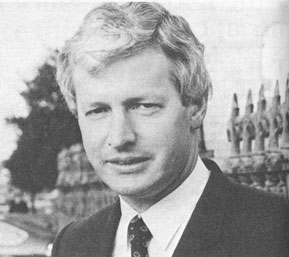 Flannery (38), was the most significant of the new people to emerge at this stage. From Galway, he was President of the Union of Students of Ireland in the early 'seventies. Later he joined the National Rehabilitation Centre and became its chief executive. He got involved with Fine Gael in the late 'seventies and helped Eddie Collins on an education policy sub-committee. In June 1981 he was involved in the literature committee, originally under Ted Nealon, and in the February election he unobtrusively emerged as a person with a very sound judgement and a marvellous command of electoral statistics.
Flannery (38), was the most significant of the new people to emerge at this stage. From Galway, he was President of the Union of Students of Ireland in the early 'seventies. Later he joined the National Rehabilitation Centre and became its chief executive. He got involved with Fine Gael in the late 'seventies and helped Eddie Collins on an education policy sub-committee. In June 1981 he was involved in the literature committee, originally under Ted Nealon, and in the February election he unobtrusively emerged as a person with a very sound judgement and a marvellous command of electoral statistics.
The strategy committee went in pairs into the key constituencies, notably, Louth, Sligo-Leitrim, Mayo East, Laois‡Offaly, Wexford, Kerry North, Clare, Galway West, Dublin South West, Dublin North West and Dublin Central. They spoke to the sitting TDs, the former candidates, the local councillors and the officials of the party organisation. Their purpose was to identify the correct candidate location strategy and, where possible, to identify candidates. They also prepared the ground for an elaborate vote management strategy which was to result in a number of critical seat gains in the recent election.
A classic case was Wexford. There the constituency review committee members identified Avril Doyle as the best candidate. They then, in cooperation with the two sitting TDs, Ivan Yates and Michael D'Arcy, organised an elaborate vote management exercise to ensure that in the early counts Avril Doyle would be ahead of the Labour candidate Brendan Howlin - both Doyle and Howlin are from Wexford town. Thus with the elimination of Howlin, Doyle was certain to be elected. The strategy committee was alone in identifying Wexford as a possible gain constituency for Fine Gael and this was to prove a crucial one in the election.
Another exercise of similar ingenuity occurred in Galway West. There the problem of too many candidates in the past was identified. This resulted in the Galway city candidate for the party being behind Michael D. Higgins in the early counts and thereby being eliminated and transferring votes to him. The strategy was in November to have just three candidates in all - John Donnellan, the sitting TD from the east of the constituency, a single candidate from Connemara and a Galway city candidate, who turned out to be Fintan Coogan jnr. The strategy worked perfectly and Michael D. Higgins lost his seat in the Dail.
While there were these notable successes, the main benefit of the work of the constituency review committee was in ensuring that the candidate problem was defused well before an election took place at all. Peace broke out in almost all constituencies and the maximum advantage was derived from the Fine Gael performance in the election - the party won just 39.1% of the first preference votes and yet won 46.4% of the seats.
The November Campaign
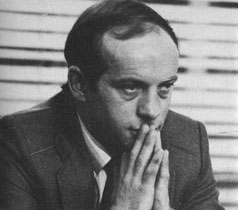 The strategy committee started to meet regularly again when the fall of the Haughey Government loomed in June over the Finance Bill. Then for the first time Bill O'Herlihy of RTE fame and a noted public relations practitioner, joined the committee for the first time. Dan Egan, who took over as press officer when Liam Hourican went in as Government press secretary in July 1981, had come on to the committee for the February election. Michael Conway of Carlow came on in July 1982 - he had been advisor to Alan Dukes in the Department of Agriculture and had a very detailed knowledge of the constituencies. He dropped out before the November campaign began to become director of elections in Carlow-Kilkenny.
The strategy committee started to meet regularly again when the fall of the Haughey Government loomed in June over the Finance Bill. Then for the first time Bill O'Herlihy of RTE fame and a noted public relations practitioner, joined the committee for the first time. Dan Egan, who took over as press officer when Liam Hourican went in as Government press secretary in July 1981, had come on to the committee for the February election. Michael Conway of Carlow came on in July 1982 - he had been advisor to Alan Dukes in the Department of Agriculture and had a very detailed knowledge of the constituencies. He dropped out before the November campaign began to become director of elections in Carlow-Kilkenny.
A number of new politicians joined the strategy committee in July 1981. These were John Boland, Jim Mitchell, Paul Connaughton and Peter Barry. All left when the campaign began. Another highly significant development in the case of the November election was that Peter Prendergast, who had resigned from the Department of Finance, was back on the strategy committee.
O'Herlihy had got involved with Fine Gael through Ted Nealon in 1977. Nealon, who had been the Government Press Secretary, was asked by Liam Cosgrave to stand for the party in Clontarf and a group of his mates rallied around to help out. These included O'Herlihy, another public relations celebrity; Pat Henehan, then of Carrolls and now in tandem with O'Herlihy in Public Relations Practitioners of Ireland; Joe Jennings of CIE and Enda Marren.
This casual grouping came together again under Marren during the 1979 Euro elections campaign and were joined by Shane Molloy. That campaign marked the first sophisticated public relations exercise in Irish politics and was highly successful at that time. The group was effectively appropriated by Nealon, then Fine Gael press officer, after the '79 campaign and they formed part of a publicity committee within the party. They worked in the 1981 campaign at Fine Gael headquarters and were joined by the Cork chemist, John Blair, and a party stalwart from Mullingar, Billy Butler - Butler and Blair were responsible for the paper hats and tee-shirts in '81.
During the course of the Coalition Government's seven months in office O'Herlihy felt that a more professional public relations approach was required and sent a memo to Government, which resulted in the establishment of a cabinet sub-committee, comprising of Peter Barry, Paddy Cooney, Jim Dooge, Liam Hourican, the Government press secretary, Joe Jennings, then the head of the GIS, Pat Henehan, Shane Molloy and Enda Marren. In the event not much came of this committee because of the pressures on the ministers' time. The success of the constituency review committee in dealing with the problems in the constituencies, greatly simplified the work of the strategy committee, which by the time it approached its third election campaign was positively purring with efficiency.
Little of consequence happened during the course of the recent campaign (although the Berkeley Court breakfast meetings were abandoned for an 8.00 am meeting in the Fine Gael headquarters "with the papers read"), bar of course the policing issue, which jolted the committee and the party for a few days. The raising of a new issue ran counter to the strategy committee's own recommendations after the '81 campaign and the misrepresentations that it gave rise to posed problems for a while.
However. the policing issue did have some tangible spin-off benefits. It was established at the outset of the November campaign that there was to be no policy advantage or disadvantage by Fine Gael vis-a-vis Fianna Fail, although there was worry over the public expenditure, of which more in a moment. The only real difference was going to be on the credibility and leadership issues.
Fine Gael took a decision at the outset not to exploit the series of disasters that had befallen the Fianna Fail Government since March - the electorate was already well aware of these. Therefore the only issue was to be leadership and this had to be played in a manner that was adroit without being unduly provocative - the strategy committee recognised that Fine Gael had no chance of becoming the largest party without "converting" some Fianna Fail voters and this would be made all the more difficult by any baiting exercises.
The plan was to end the campaign on a credibility upswing however and there was some difficulty in determining how this could best be done. The all-Ireland policing controversy played into Fine Gael's hands, for it kept the credibility alive right through to the end of the campaign. In this they were assisted ably by the Fianna Fail Attorney General, John Murray.
Bill O'Herlihy and the Party Political Broadcasts
O' Herlihy was responsible for the political party broadcasts and itwas he who devised the cruel satirical dig at Fianna Fail in the "you can't have one without the other" series. This was devised to convey to voters that voting for perhaps the more acceptable face of Fianna Fail, the dissidents, was in fact voting for Haughey. The commercial proved controversial, but judging by the results of the election, effective.
O'Herlihy was also responsible for the broadcast deriding the "Government economic plan. "The Way Forward". This showed a man walking along a street reading first the 1977 Fianna Fail manifesto, then the series of O'Donoghue plans, then the Haughey investment plan and finally the economic plan,at which point the reader fell into a manhole. He also plugged the team element in Fine Gael and, at the suggestion of the soccer pundit, Eamon Dunphy. he used the Mise Eire music as background to the bright new dawn which Fine Gael would herald. The broadcasts were tough and very slick. Reminiscent of the best of American political commercials - perhaps those devised by Bob Haldeman for the Nixon campaign in 1968?
O'Herlihy was also very much involved in coaching Fitz‡ Gerald for the television debate. In fact, FitzGerald's very much more improved performance in the November debate, in contrast to the February encounter with Haughey, owed more to the BBC than to O'Herlihy or even to Bunny Carr. For the Dimbleby lecture last May FitzGerald had to undergo several hours of coaching to be able to perform adequately over his one hour address-. He learned a lot of the new techniques of television then and was sharpened by a session with Bunny Carr a few days before the debate.
FitzGerald was very much more confident on this occasion and very much more concentrated. He avoided any distractions in the studio before the debate and even left the studio during the Dick Spring interview to be fully concentrating on his own performance. FitzGerald, as coached, never used a statistic throughout the debate and used a technical economic term (GNP) only once.
The Issues
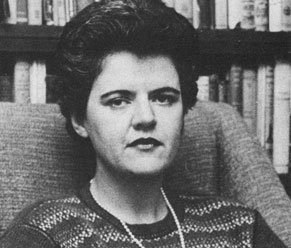 And finally, to the issue that might have been a substantive one in the November election, the Government's publication of the book of estimates. The strategy committee advised the politicians to deride the estimates before their publication and then after publication to ignore them, or rather to agree with them. This was done and the issue died a death. There might just have been a genuine debate on some issue of substance had the estimates been taken up and debated but the November election was not about debate or about issues; it was about marketing and presentation.
And finally, to the issue that might have been a substantive one in the November election, the Government's publication of the book of estimates. The strategy committee advised the politicians to deride the estimates before their publication and then after publication to ignore them, or rather to agree with them. This was done and the issue died a death. There might just have been a genuine debate on some issue of substance had the estimates been taken up and debated but the November election was not about debate or about issues; it was about marketing and presentation.
While all the frenetic organisational and strategic activity was going on from March last, really only John Bruton was giving any thought to policy. He wrote to all the embassies on leaving office and asked them for ideas on employment policies. He then started a detailed research project on employment policy, which eventually saw the light of day under the title "Jobs in the Eighties". He did it almost entirely off his own bat; almost nothing else was done on policy during the period. And the strategy committee devised strategies to ensure that no policies would obtrude on Election '82. Mark II - it was all about credibility and professionalism.
